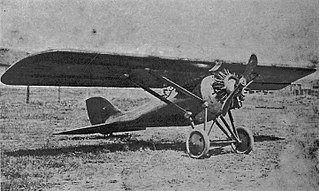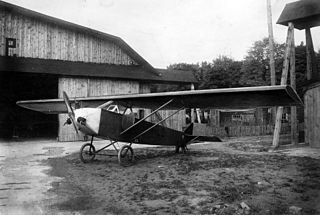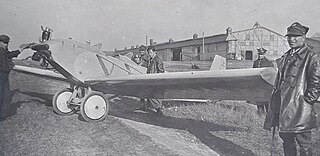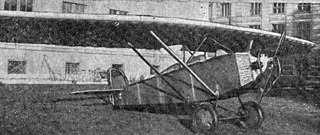Related Research Articles
The Peitz 101, aka Peitz Avionette, was a French, amateur-built, all-metal light aircraft, first flown during the winter of 1931–32.

The Hanriot H.34 was a basic trainer designed in France in 1924 which did not reach production. It was a parasol wing aircraft, seating two in tandem.

The Skraba S.T.3 was a two-seat Polish biplane built in 1928. It was the first all-metal aircraft designed in Poland; only one was completed.

The Peyret-Nessler Libellule (Dragonfly) was a French two-seat, low-powered parasol wing light aircraft built in 1927 to provide practical but economical flying. It was one of the first of these French avionettes.

The low-powered Samolot Sp.I, designed in Poland in the mid-1920s, was intended to explore the characteristics of a proposed single seat fighter. The project did not receive government support and only one Sp.1 was built.

The Medwecki HL 2 was a Polish two seat lightplane flown in 1927. Handicapped by a low power, unreliable engine, its flying life lasted little more than a month.

The Offierski O.2 was a one-off, two seat, low powered lightplane built in Poland on the late 1920s. It flew in 1928 but an old and unreliable engine prevented its development.
The Medwecki and Nowakowski M.N.3 or just M.N.3 was a low-powered, four seat, Polish aircraft flown in 1928. The sole example was modified into a more powerful two-seater which served aeroclubs until World War II.

The Rogalski and Wigura R.W.1 was designed and built by a pair of students at Warsaw Technical University in 1927. The single example was a two-seat parasol-wing monoplane which entered two national competitions, served the Warsaw Academic Aeroclub and also towed an advertising banner.
The Gabriel P 6 was a Polish training aircraft and the P 7 a tourer. The difference between them was the wing configuration, chosen to optimise their speed range for their role, so the P 6 was a biplane and the P 7 a parasol wing aircraft.
The Silesia S-4 was a Polish, low-power parasol wing aircraft built in 1925. After an engine change and airframe modifications it became one of the Silesian Aeroclubs fleet. It was lost in a take-off accident in 1931 and was the last Silesia aircraft to fly.

The Działowski D.K.D.1 was the first powered aircraft designed by Stanislaw Działowski. It was a low-power high-wing monoplane with a cabin for one passenger. After attending an aviation exhibition in Warsaw in 1927 it was badly damaged when the engine failed as it left and it did not fly again.
The Działowski D.K.D.4 was a Polish, parasol-wing, sports two-seater built in 1928. One won the Second National Lightplane Contest, with another coming fifth.

The Zalewski W.Z.XI Kogutek I was a basic, single seat sport aircraft designed and built in Poland in the 1920s. Its engine was also designed and built by Zalewski, making it the first all-Polish aircraft to fly.

The all-wood Kozłowski WK.1 Jutrzenka (Dawn) was a two-seat low wing monoplane designed and built in Poland over 1926-7.
The Grzmilas Orkan II was a Polish one-off, single-seat sports aircraft. It came second in the second National Lightplane Contest held soon after its first flight, with outstanding take-off and climb characteristics. Its designer and builder continued to use it until 1939.
The LKL IV and LKL V were a pair of very similar Polish parasol wing two-seaters, built in the early 1930s. They differed primarily in their engines.

The Sido S.1 was a Polish two seat, parasol wing trainer aircraft, first flown in 1930.
The Gabriel Śląsk (Silesia) was a Polish light aircraft designed and built by an amateur in the mid-1930s. After two flights the Polish authorities banned further development.
The Stiles Dragon Fly was an American two seat monoplane aircraft of the late 1920s. It was aimed at private and club owners. Significant production was planned but few were built.
References
- 1 2 3 4 5 6 7 8 9 Cynk, Jerzy (1971). Polish Aircraft 1893-1939 . London: Putnam Publishing. p. 602-4. ISBN 0 370 00085 4.
- 1 2 3 "DKD-III, 1927" . Retrieved 21 December 2017.
- ↑ "Golden Years of Aviation" . Retrieved 23 December 2017.